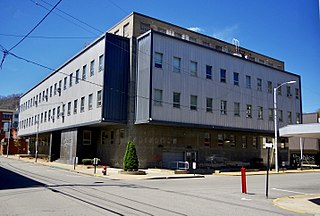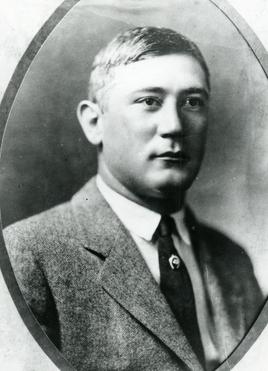Related Research Articles

Mingo County is a county in the U.S. state of West Virginia. As of the 2020 census, the population was 23,568. Its county seat and largest city is Williamson. Created in 1895, Mingo is West Virginia's newest county, named for the historic Iroquoian Mingo people.

Logan County is a county in the U.S. state of West Virginia. As of the 2020 census, the population was 32,567. Its county seat is Logan. Logan County comprises the Logan, WV Micropolitan Statistical Area, which is also included in the Charleston–Huntington–Ashland, WV–OH–KY Combined Statistical Area.

Thurmond is a town in Fayette County, West Virginia, United States, on the New River. The population was five at the 2020 census. During the heyday of coal mining in the New River Gorge, Thurmond was a prosperous town with a number of businesses and facilities for the Chesapeake and Ohio Railway.

Matewan is a town in Mingo County, West Virginia, United States at the confluence of the Tug Fork River and Mate Creek. The population was 499 at the 2010 census. The Norfolk Southern Railway's Pocahontas District passes through the town. It was a key site of the Coal Wars and the location of the Battle of Matewan in 1920.
The Baldwin–Felts Detective Agency was a private detective agency in the United States from the early 1890s to 1937. Members of the agency were central actors in the events that led to the Battle of Blair Mountain in 1921 and violent repression of labor union members as part of the Coal Wars in such places as the Pocahontas Coalfield region of West Virginia, the Paint Creek–Cabin Creek strike of 1912 in West Virginia, 1913–1914 Colorado Coalfield War, and the Battle of Matewan in 1920.
The Battle of Matewan was a shootout in the town of Matewan in Mingo County and the Pocahontas Coalfield mining district, in southern West Virginia. It occurred on May 19, 1920 between local coal miners and their allies and the Baldwin–Felts Detective Agency. The dead included two brothers of the detective agency's founder and Matewan's mayor Cabell Testerman, who supported the union.

The Battle of Blair Mountain was the largest labor uprising in United States history and the largest armed uprising since the American Civil War. The conflict occurred in Logan County, West Virginia, as part of the Coal Wars, a series of early-20th-century labor disputes in Appalachia. Up to 100 people were killed, and many more arrested.

The New River Coalfield is located in northeastern Raleigh County and southern Fayette County, West Virginia. Commercial mining of coal began in the 1870s and thrived into the 20th century. The coal in this field is a low volatile coal, known as "smokeless" coals. The seams of coal that have been mined include Sewell, Fire Creek, and Beckley. This is very high quality bituminous coal rated at approximately 15,000 BTU (16,000 kJ). The New River coalfield is named after the north flowing New River. Over 60 coal towns were once located there, supported by independent commercial districts at Beckley, Oak Hill, Mount Hope, and Fayetteville. By the 21st century many coal camps had partially or completely returned to nature. These company towns were located along Dunloup (Loup) Creek, Laurel Creek, White Oak Creek, lower Piney Creek, and, of course, the New River. The mainline of the Chesapeake and Ohio Railway ran right through the center of this coalfield, with spurs branching off in many directions, and rail yards were maintained at Quinnimont, Raleigh, and Thurmond, WV. The Virginian Railway's main line also passed through the western side of the field as well. Companies such as the New River Company, New River & Pocahontas Consolidated Coal Co., and Mary Frances Coal Co. were the largest operators in the New River Coalfield, but there were many smaller ones as well. These companies recruited native born whites, immigrants from Southern and Eastern Europe, and African-Americans from the South to work in their coal mines and railroads. The mines began to close down after World War II and today there are very few active coal mines in the field. The New River Gorge is now the domain of the National Park Service as the New River Gorge National Park and Preserve, and they have done what their budget allows to preserve the coal heritage of the area.
The Logan Coalfield is a coalfield located in Logan County and Wyoming County of southern West Virginia, in the Appalachia region of the eastern United States.

The West Virginia coal wars (1912–1921), also known as the mine wars, arose out of a dispute between coal companies and miners.

The Matewan Historic District encompasses the town center of the rural coal mining community of Matewan, West Virginia. Matewan was the scene of the Battle of Matewan on May 19, 1920, during a coal miners' strike, an event which led to the Battle of Blair Mountain, the largest insurrection ever associated with the labor movement in the United States, and was depicted in the film Matewan. It was designated a National Historic Landmark in 1997.

Kay Moor, also known as Kaymoor, is the site of an abandoned coal mine, coal-processing plant, and coal town near Fayetteville, West Virginia. The town site is located in the New River Gorge at Kaymoor Bottom (38°03′00″N81°03′17″W). It is linked to the mine portal 560 feet (170 m) above on Sewell Bench (38°02′52″N81°03′58″W) in the wall of the Gorge by conveyors.

Don Chafin was the sheriff of Logan County, West Virginia and a commander in the Battle of Blair Mountain. As sheriff of Logan County, Chafin was a fierce opponent of unionization and received hundreds of thousands of dollars from coal mine operators in bribes for his violent suppression of the United Mine Workers union.

Copperas Mine Fork is a tributary of Island Creek, 9.3 miles (15.0 km) long, in southern West Virginia in the United States. Via Island Creek and the Guyandotte and Ohio rivers, it is part of the watershed of the Mississippi River, draining an area of 45.4 square miles (118 km2) in a rural area on the unglaciated portion of the Allegheny Plateau, in the Logan Coalfield. The Copperas Mine Fork's entire course and drainage area are in Logan County.
The National Coal Heritage Area (NCHA) is a federally designated National Heritage Area encompassing a region of thirteen counties in West Virginia that were the source of "smokeless" bituminous coal through much of the 20th century. The National Heritage Area recognizes the area's cultural and historic qualities and serves to promote tourism, historic preservation and economic development in the region. The idea of the NCHA was first proposed in the early 1990s by Congressman Nick Rahall, and was established on November 12, 1996 by the 1996 Omnibus Parks and Public Lands Management Act. The designated area includes Boone, Cabell, Fayette, Logan, Lincoln, McDowell, Mercer, Mingo, Raleigh, Summers, and Wayne counties.
The coal towns, or "coal camps" of Fayette County, West Virginia were situated to exploit the area's rich coal seams. Many of these towns were located in deep ravines that afforded direct access to the coal through the hillsides, allowing mined coal to be dropped or conveyed downhill to railway lines at the valley floor. Many of these encampments were set up as company towns, and when their mines closed, the towns vanished. A few, like Thurmond, West Virginia, have survived in a reduced state. Fayette County covers portions of three coalfields: the New River Coalfield, the Kanawha Coalfield and the Greenbrier Coalfield. Below is a partial list of known coal towns within the three coalfields: the New River Coalfield, the Kanawha Coalfield and the Greenbrier Coalfield. More may be found here
The coal mining communities, or coal towns of Raleigh County, West Virginia were situated to exploit the area's rich coal seams. Many of these towns were located in deep ravines that afforded direct access to the coal through the hillsides, allowing mined coal to be dropped or conveyed downhill to railway lines at the valley floor. Many of these encampments were set up as coal towns, and when their mines closed, the towns vanished. Raleigh County covers portions of three coalfields: the New River Coalfield, the Winding Gulf Coalfield and the Coal River Coalfield. Below is partial listing of known coal towns. Further listings are available here
The coal mining communities, or coal towns of McDowell County, West Virginia were situated to exploit the area's rich coal seams. Many of these towns were located in deep ravines that afforded direct access to the coal through the hillsides, allowing mined coal to be dropped or conveyed downhill to railway lines at the valley floor. Many of these encampments were set up as company towns, and when their mines closed, the towns vanished. McDowell County covers much of the Flat Top-Pocahontas Coalfield and a small portion of the Williamson Coalfield.

The Coal Wars were a series of armed labor conflicts in the United States, roughly between 1890 and 1930. Although they occurred mainly in the East, particularly in Appalachia, there was a significant amount of violence in Colorado after the turn of the century.
Charles Everett Lively was an American private detective who worked as a labor spy for the Baldwin–Felts Detective Agency. He played an active role in the Coal Wars in Appalachia and Colorado during the early 20th century.
References
- ↑ Sharon A. Brown (July 13, 1990). "National Register of Historic Places Nomination: Kay Moor" (PDF). National Park Service.
{{cite journal}}: Cite journal requires|journal=(help) - 1 2 "Mingo County, West Virginia" (PDF). National Coal Heritage Area. Coal Heritage Highway Authority. Retrieved March 14, 2012.